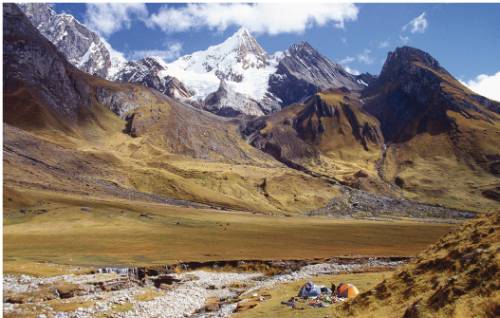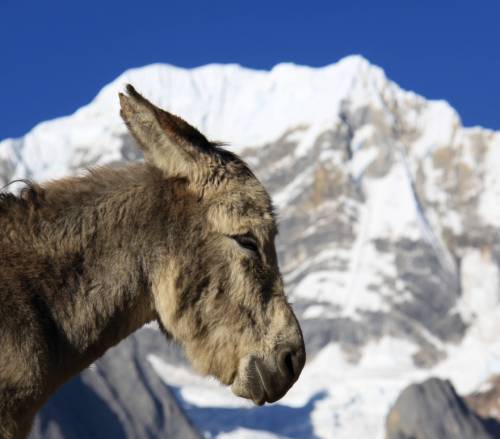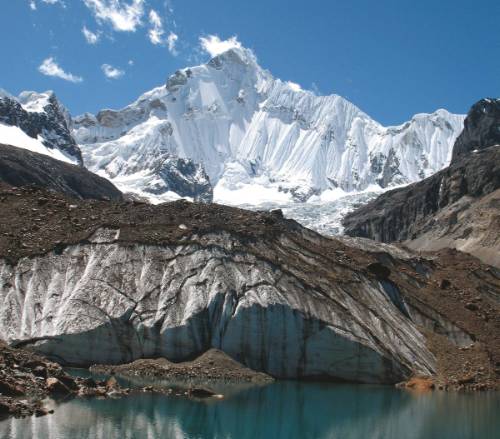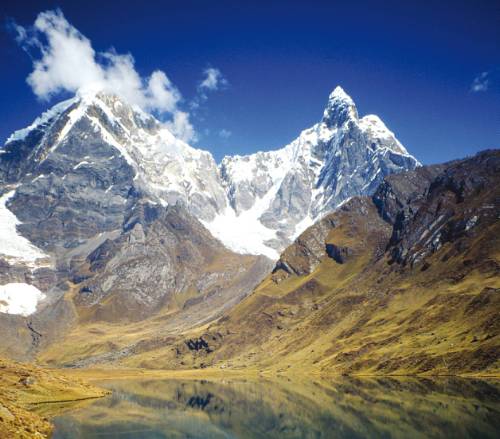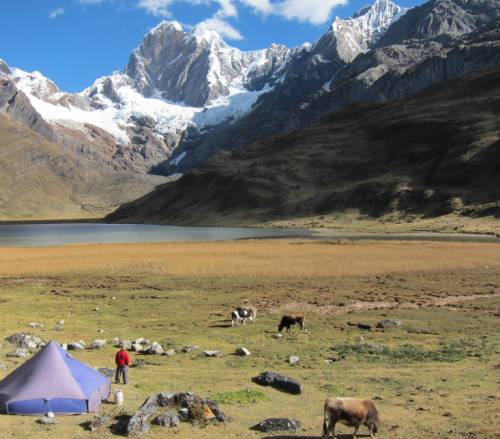Huayhuash Circuit
Huayhuash Circuit
$4190
Tour Overview
Embark on an unforgettable adventure with the Huayhuash Circuit, a challenging 127 km trek through the breathtaking Cordillera Huayhuash in Northern Peru. This journey offers some of the best trekking experiences in South America, with towering peaks over 6000m, cascading glaciers, and azure glacial lakes. Begin your exploration in Lima, then travel to Huaraz, the gateway to the stunning Cordillera Blanca. Experience the rich culture of indigenous communities and the fragile ecosystems they inhabit. Throughout the trek, enjoy fully supported camping with quality tents and expert guidance. Capture endless photo opportunities of the incredible landscapes, from the majestic peaks to the serene alpine meadows. With all internal transportation provided and comfortable accommodations, this adventure promises both challenge and comfort, making it a perfect choice for those seeking an authentic and immersive trekking experience in Peru. ...more ...less
Highlights
Itinerary
Day 1 : Arrive Lima
Location: Lima, Miraflores, Lima, Museo de La Nacion, Lima, Larco Herrera Museum, Lima
Accommodation Name: Hotel in Miraflores
If you’re flying into Lima today you will be met at the airport and transferred to the group hotel, where the remainder of the day is free at leisure for you to rest or start exploring. We plan to have a group briefing before dinner, however this will be subject to all group members arriving during the day – otherwise we will have the briefing tomorrow. Our hotel is in the Miraflores area, home to some of Lima’s best galleries, restaurants and shops. Steeped in fascinating history, Lima is South America’s oldest capital. It was in 1535 that the Spanish conquistador Francisco Pizarro overthrew the Inca Empire and moved the capital from Cusco, establishing the new city of Lima. Peru’s busy capital is now a sprawling metropolis that’s blessed with world-class restaurants, brilliant museums and galleries, and a superb combination of Spanish colonial and 19th century European architecture. If you have time to visit a museum we would recommend the Museo de La Nacion or the Larco Herrera Museum.
Overnight in Lima. ...more ...less
Day 2 : Drive to Huaraz
Location: Huaraz
Accommodation Name: Hotel in Huaraz
Today we travel to Huaraz, our gateway to the stunning Cordillera Blanca. It’s a long day’s journey but we’ll be treated to some incredible scenery along the way. Groups operating with 10 or more people will have private transport. For smaller groups, we will travel with our guide on a comfortable tourist class air-conditioned coach which provides restrooms, reclining seats and touch screens.
Day 3 - 4 : In Huaraz, day hikes
Location: Huaraz, Cordillera Negra, Laguna Wilcacocha
Accommodation Name: Hotel in Huaraz
We now have two days in Huaraz to explore this stunning region with some day walks—and at an elevation of 3,052 m (10,013 ft), our time spent in Huaraz is crucial to our safe acclimatisation. Huaraz is a scenic town set at the foot of the Cordillera Blanca with views directly up to the highest peak in Peru, Huascaran (6,768 m / 22,205 ft). There is a range of different walking excursions we can make from our base here for a couple of days, and these hikes will be invaluable acclimatisation for our trekking program ahead. As the gateway to the Cordillera Blanca, Huaraz is a bustling tourism hub and also serves as a pick up point for our crew and all supplies and equipment for the trek. On Day 3, we enjoy a 4hr loop walk on the Cordillera Negra to Laguna Wilcacocha (3,714m / 12,185ft). It is one of the simplest hikes to do, given its closeness to Huaraz, with some fantastic views over the impressive peaks of the Cordillera Blanca range. On Day 4, we make a day trip to Laguna Churup (4,485 m / 14,715 ft), a beautiful glacial lake set at the base of Nevado Churup (5,493 m / 18,022 ft). This is one of the most popular day treks in the Cordillera Blanca and takes around 4–5 hours to complete. Today’s trek is an excellent training and acclimatisation hike for our upcoming Huayhuash Circuit, and our efforts will be justly rewarded when we arrive at this stunning turquoise glacial lake.
Overnight in Huaraz.
Day 5 : Drive to Pukatzaka and trek to Jahuacocha (trekking time approx. 2 hours)
Location: Huaraz, Conococha Lake, Pacllon, Pukatzaka, Jahuacocha Lake
Accommodation Name: Campsite at Matacancha
Today we head south of Huaraz to our first campsite Jahuacocha (4,050 m / 13,287
ft). Today we get our first glimpses of the Huayhuash range, we’ll pass Conococha
Lake and the pinteresque Pacllon village. After around 5 hours of driving, we’ll arrive
at our trail head, Pukatzaka (3,900m / 12,795ft), where our “arrieros” (muleteers) and “burros” (donkeys) will be waiting. After around 2 hours of gently climb, we’ll arrive at our first night’s camp at Jahuacocha, a beautiful place, a perfect location to appreciate
a beautiful sunset. Camp around the Jahuacocha Lake.
Overnight: Wilderness Camp
Day 6 : Trek to Matachancha via Sambunya Pass (trekking time approx. 7 hours)
Location: Cordillera Huayhuash
Accommodation Name: Campsite at Janca
Amazing trek to Sambunya Pass at 4,760m (15,617 ft.) surrounded by white peaks of the Huayhuash Mountain Range, spending approximately 4 to 5 hours. Moderately descent over a nice trail with abundant vegetation, flowers and colorful landscape to Rondoy Valley for about 1.5 hrs. From here, one hour of gently climb leads us to Matacancha camp located at 4,198m (13,773ft.)
Overnight: Wilderness Camp
Day 7 : Trek to Mitucocha vía Cacananpunta Pass (trekking time approx. 7 - 8 hours)
Location: Cacananpunta Pass, Janca, Mitucocha Lake
Accommodation Name: Campsite at Lake Carhuacocha
Trekking to our first pass and crossing the divide to the east, we gain our first serious views of the mountains. Zigzagging steadily upwards over rocky and loose terrain above our previous night’s camp, the trail then becomes steep in a final hill across to the Cacananpunta Pass (4,684 m / 15,420 ft). From here we descend briefly before contouring the hillside to find the mountains at the north end of the Huayhuash opening out before us: Ninashanca (5607 m / 18,396 ft), Rondoy (5879 m / 19,288 ft), Jirishanca (6,094 m / 19,993 ft) and Jirishanca Chico (5445 m / 17,864 ft) among them. Our path descends to the village of Janca (4,244 m / 13,923 ft), where we'll find our camp by the river, surrounded by mountain vistas. In the afternoon there is an optional hike to Mitucocha Lake. Overnight at campsite.
Overnight: Wilderness Campsite
Day 8 : Trek to Lake Carhuacocha via Carhuac Pass (trekking time approx 6 hours)
Location: Lake Carhuacocha, Carhuac Pass, Yerupaja
Accommodation Name: Campsite at Huayhuash
Today we trek for around 6 hours, making our way to Lake Carhuacocha (4,180 m / 13,914 ft). After trekking south for 3-4 hours, steadily gaining altitude, we reach the Carhuac Pass (4,633 m / 15,256 ft). The trail then drops steeply for the next hour, passing a couple of dwellings at Yanayana and then a small lake, before the one-kilometer-long emerald green Laguna Carhuacocha comes into view. If we’re lucky we may see the Andean geese that are often spotted on the lake. Tonight’s camp is set above the lake, beneath the eastern flanks of Yerupaja Chico and Yerupaja, the latter being the centrepiece of the massif and the second highest mountain in Peru, after Huascaran (6,768 m / 22,205 ft). Yerupaja is the highest point of the vast Amazon basin watershed that feeds into the Rio Marañón, a principal tributary of the Amazon. Overnight at campsite.
Overnight: Wilderness Camp
Day 9 : Trek to Huayhuash village via Siula Pass (trekking time approx. 7 hours)
Location: Cordillera Huayhuash, Siula Pass, Huayhuash Campsite
Accommodation Name: Campsite at Viconga Lake
Photographers are advised to wake up before dawn this morning to watch the sunrise over the Lake and Peaks from our campsite. The sun’s first rays catching the peak of Mt Yerupaja (6,634 m / 21,765 ft) certainly make the effort more than worthwhile. Today is a long gradual climb up a beautiful valley surrounded by the splendor of Yerupaja, Yerupaja Chico, Siula Grande, Jirishanca, Santa Rosa and Carnicero and past the lakes Gangrajanca, Siula and Quesillacocha. Then we climb steeply to the top of the rocky Siula Pass (4836m / 15,866 ft). Descend to Huayhuash Campsite (4,353 m / 14,281 ft) surrounded by other mountains such as Trapecio and the three Jurau’s peaks.
Overnight: Wilderness Camp
Day 10 : Trek to Viconga Lake via Portachuelo de Huayhuash (trekking time approx. 5 hours)
Location: Portachuelo de Huayhuash, Viconga Lake, Coñuc Thermal Springs
Accommodation Name: Campsite at Pampa Cuyoc
We begin our day ascending towards the Portachuelo de Huayhuash Pass sitting at 4,750 (15,583 ft). We will be surrounded by remarkable views of the Cordillera Huayhuash's snowcapped Trapecio and Puscanturpa glacial peaks as well as the snow-capped peak, León Huacanan sitting at 5,427m (17,805 ft) in the Cordillera Raura. We will begin our descent down the massive Viconga lagoon which is towered over by the glacial peaks of the Cordillera Raura. We will make our way to the Coñuc thermal springs 4,367m (14,327 ft) where we’ll spend the rest of our day relaxing in either of the two hot springs much needed after several days of trekking.
Overnight: Wilderness Campsite
Day 11 : Trek to Huanacpatay Valley via Cuyoc Pass (trekking time approx. 5 - 6 hours)
Location: Cuyoc Pass, Cordillera Huayhuash, Quebrada Huanacpatay, Pampa Cuyoc
Accommodation Name: Campsite at Cutatambo
We commence the day with a 3 hour steady uphill walk to our second highest pass of the trek, Cuyoc, 5047m (16558 ft). Here we are welcomed with stunning southwest panoramic view of the Cordillera Huayhuash. The views are breathtaking; to the southeast we’ll see the Cordillera Raura’s 5,000-meter jagged peaks, and to our north we’ll see the giants of the Huayhuash mountain range. After the pass, our trek gets easier with a steep 50-meter descent into the wide valley of the Quebrada Huanacpatay. Upon reaching the valley, we will continue on to our camp at Pampa Cuyoc, 4,530m (14,862ft).
Overnight: Wilderness Camp
Day 12 : Trek to Cutatambo via Santa Rosa Pass (trekking time approx. 5 - 6 hours)
Location: Santa Rosa Pass, Siula Lake, Sarapo Lake, Jurau Lake, Jurau Valley, Cutatambo
Accommodation Name: Campsite at Cutatambo
Today we cross the highest pass of our trek, the Santa Rosa Pass (5,078 m / 16,660 ft). We begin with a 3-hour ascent to the pass, where we’ll have views of three glacial lakes: Siula, Sarapo and Jurau. From the pass we begin our descent into the Jurau Valley, making our way to our camp at Cutatambo (4288 m / 14,068 ft), passing the beautiful lakes we saw this morning from afar.
Overnight: Wilderness Camp
Day trek to ascend Cerro Bella Vista (trekking time approx. 5 hours)
Location: Cerro Bella Vista, Cutatambo
Accommodation Name: Campsite at Huatiac
Today we’ll be using our camp at Cutatambo as a base while we pack a picnic lunch and head out on a day trek to the summit of Cerro Bella Vista (5,150 m / 16,896 ft). Today’s excursion offers what are arguably some of the best views in all of Peru! After a fulfilling day in the mountains, we descend back to our camp at Cutatambo for the night.
Overnight: Wilderness Camp
Day 14 : Trek to Huayllapa village via Jurau Valley (trekking time approx. 7 hours)
Location: Jurau Valley, Huayllapa, Huatiac, Diablo Mudo
Accommodation Name: Campsite at Gashpapampa
This morning, we take a half-day to descend the Jurau Valley at a leisurely pace, following the river to the pretty farmlands of Huayllapa (3,596 m / 11,79 ft). We have lunch just outside the village, then start climbing up the valley for another three hours to our beautiful camp at Huatiac (4293 m / 14,084 ft). From tonight’s scenic campsite we’ll have excellent views of the peaks of Diablo Mudo (5,223 m / 17,136 ft).
Overnight: Wilderness Camp
Day 15 : Trek to Gashpapampa via Tapush Pass (trekking time approx 6 hours)
Location: Tapush Punta Pass, Gashpapampa
Accommodation Name: Campsite at Jahuacocha
Leaving camp, we trek northwards and wind our way up and over a lesser-defined trail to the plateau. After around three hours we cross the Tapush Punta Pass (4,790 m / 15,715 ft), continuing on past a small glacial lake and several alpine meadows as we make our way to our next campsite, a couple of hours away. Camp in Gashpapampa (4,556 m / 14,947 ft).
Overnight: Wilderness Camp
Day 16 : Trek to Jahuacocha via Yaucha Pass (trekking time approx. 5 hours)
Location: Yaucha Pass, Jahuacocha Lake
Accommodation Name: Campsite at Jahuacocha
We start today with a 2,5-hour ascent to our last mountain pass of the trek, Yaucha pass (4,848 m / 15,905 ft), followed by an easy descent to Jahuacocha Lake at 4,076 m / 13,372 ft. (It was our first campsite and today our last campsite). In this way we will be completing a complete a loop in Huayhuash Mountain Range. If this circuit trek had a highlight, it would most likely be the views from this camp, truly encapsulating the wild beauty of the Huayhuash range. There is a small community living nearby that can often be seen fishing for trout in the pristine lake in their spare time.
Overnight: Wilderness Camp
Day 17 : Trek to Pukatzaka and drive to Chiquian (trekking time approx. 2 hours)
Location: Pukatzaka, Chiquian
Accommodation Name: Hotel in Chiquian
We hike down for approximately 2 hours to the trail end of our trek, Pukatzaka. Here we say good bye to our staff. We will meet here our vehicle and driven to Chiquian town.
Overnight: Local hotel in Chiquian.
Day 18 : Drive to Lima
Location: Lima
Accommodation Name: Hotel in Lima
Today we make our way by private vehicle south to Lima. A full day’s driving of around 8 hours.
Overnight in Lima.
Day 19 : In Lima, trip concludes
Location: Lima
Meals Included: Breakfast
After breakfast, our trip concludes. If you are flying home today, you will be transferred to the airport in time for your departure.
What's Included
-
Accommodation
5 nights hotel -
Airport Transfers
Airport transfers are included if arriving on Day 1 and departing on Day 19.
-
Expert Bilingual Guide
An expert bilingual guide will accompany you throughout the journey.
-
Group Medical Kit
A group medical kit is provided for the safety of all participants.
-
Internal Transportation
All internal transportation is via private vehicle, except for Lima to Huaraz, which is on a comfortable tourist class coach for groups up to 9 travelers.
-
Gear Pack
The use of a gear pack including a sleeping bag, fibre filled jacket, and thermarest sleeping mat is included.
-
Group Camping Equipment
Group camping equipment is provided for the trekking section.
-
Pack Animals or Porters
Pack animals or porters are provided on the trek to carry personal gear.
-
Portable Altitude Chamber
A portable altitude chamber is carried on the trek for safety.
What's Not Included
-
Cost of Laundry and Alcoholic Beverages
The cost of laundry and alcoholic beverages (except wine on the last trek day) is not included.
-
Medical Treatment
Medical treatment is not included in the tour package.
-
International Flights
International flights are not included in the tour package.
-
Airport Taxes
Airport taxes are not included in the tour package.
-
Excess Baggage Costs
Excess baggage costs are not included in the tour package.
-
Travel Insurance
Travel insurance is not included and is the responsibility of the traveler.
-
Visas
Visas are not included and must be arranged by the traveler.
Accommodation
Enjoy 5 nights in comfortable hotels, primarily 3-star with some 4-star options, and experience fully supported camping in quality two-person tents during the trek. In smaller towns, accommodations may be more basic, but always clean, comfortable, and well-located.
What You Carry
In your daypack you will need to carry extra warm clothing (depending on the altitude, location and weather), a rainjacket, water bottle, camera gear, valuables and personal items such as sunscreen, lip-eze etc. Porters or mules carry all group gear and your trek pack. As of December 2018, single-use plastic bottles and any other single-use plastics (bags, cups, straws, etc) are prohibited in the Historic Sanctuary of Machu Picchu, on the Inca Trail and all other protected natural areas in Peru. This regulation was established by the Ministry of Environment, following the Sustainable Tourism Regulation which aims to conserve these protected natural areas. Please ensure to bring your reusable water bottle on all our Peru trips. Water refill stations have been installed in areas near Machu Picchu and other national parks. Your guide will brief you where you can refill your water bottles with drinking water. ...more ...less
Grading
This trip is graded moderate to challenging and is suitable for fit and healthy people. Prior trekking is not necessary, although you would be expected to be comfortable in the outdoors and enjoy camping for successive days. These adventures involve trekking for up to 6 - 8 hours a day at a steady pace and may include longer days up to 10 hours. These trips may spend successive days at altitudes not generally exceeding 5,500m and the actual treks are usually between 10 and 15 days in duration. You will need a good level of fitness and be in good health.
* Suggested preparation: 45 minutes of aerobic type exercise, three to five times a week for the three months leading up to your trip. Hill walking with a pack in variable weather conditions is also recommended. To prepare for a walking holiday we recommend you take every opportunity to walk up and down stairs and/or hills, for leg strengthening and aerobic fitness. Please remember the fitter you are the more you will enjoy your holiday.
...more ...less
What You Carry
In your daypack you will need to carry extra warm clothing (depending on the altitude, location and weather), a rainjacket, water bottle, camera gear, valuables and personal items such as sunscreen, lip-eze etc. Porters or mules carry all group gear and your trek pack.
As of December 2018, single-use plastic bottles and any other single-use plastics (bags, cups, straws, etc) are prohibited in the Historic Sanctuary of Machu Picchu, on the Inca Trail and all other protected natural areas in Peru. This regulation was established by the Ministry of Environment, following the Sustainable Tourism Regulation which aims to conserve these protected natural areas. Please ensure to bring your reusable water bottle on all our Peru trips. Water refill stations have been installed in areas near Machu Picchu and other national parks. Your guide will brief you where you can refill your water bottles with drinking water.
...more ...less
Mode of Transport
Travel in private vehicles for internal transportation, except for the journey from Lima to Huaraz, which is on a comfortable tourist class coach for groups up to 9 travelers. A guide will accompany you throughout the journey.
Check out our Q&As
-
What type of accommodation can I expect during the Huayhuash Circuit tour?
During the Huayhuash Circuit tour, you will stay in a combination of hotels and campsites. In cities like Lima and Huaraz, accommodations are typically 3 to 4-star hotels, although in smaller towns, options may be more basic. During the trekking section, you will enjoy a fully supported camping experience with quality two-person tents, a dining tent, a separate cooking tent, and where appropriate, a toilet tent. ...more ...less
-
What kind of meals are provided on the tour?
The tour includes 18 breakfasts, 15 lunches, and 13 dinners. Meals are provided throughout the tour, ensuring you are well-fed during your adventure.
-
What is the transportation arrangement for the tour?
All internal transportation is via private vehicle, except for the journey from Lima to Huaraz, which is on a comfortable tourist class coach for groups up to 9 travelers. Your guide will accompany you throughout the journey.
-
What should I carry in my daypack during the trek?
In your daypack, you should carry extra warm clothing, a rain jacket, a water bottle, camera gear, valuables, and personal items such as sunscreen and lip balm. Porters or mules will carry all group gear and your trek pack.
-
What is the difficulty level of the Huayhuash Circuit trek?
The Huayhuash Circuit trek is graded as moderate to challenging. It is suitable for fit and healthy people, and prior trekking experience is not necessary. The trek involves walking for up to 6-8 hours a day at a steady pace, with some days extending up to 10 hours. The trek may reach altitudes not generally exceeding 5,500 meters. ...more ...less
-
Are there any specific regulations regarding plastic use during the tour?
Yes, single-use plastic bottles and any other single-use plastics are prohibited in the Historic Sanctuary of Machu Picchu, on the Inca Trail, and all other protected natural areas in Peru. You should bring a reusable water bottle, and water refill stations are available in areas near Machu Picchu and other national parks.
-
Who will be my travelling companions on the tour?
We have offices on three continents which means your travelling companions will be just that – international and wonderfully eclectic. Part of small group travel means that although travellers come from various locations and backgrounds, you will be travelling with like-minded companions who, like you, are keen to share the experience and forge lifelong friendships.
-
What about environmental impact?
We believe that adventure travel revolves around establishing a strong relationship with the people and environments in which we operate. Our responsible travel policies have been carefully developed to ensure that we minimise the impact of our presence and help to protect the regions we visit while contributing positively to the local community.
-
What should I pack?
Your pre-departure documents include a detailed packing list with items that you need to bring. While most of the equipment for daily activities is included in your tour cost, some items like helmets and hiking boots are best brought from home. The pre-departure documents also include information on layering and recommended brands for various items to ensure you are fully prepared for your trip.
-
Do you operate a “single share” option and how does it work?
Yes. World Expeditions does not require single travellers to pay a surcharge for travelling alone on the vast majority of our trips. Our holidays are primarily on a twin share basis, so if you are joining the group as a solo traveller, we will match you with someone of your own gender. The choice is yours however; if you prefer not to share, we do offer single supplements for private occupancy.
-
Are tips included in my trip price?
Tips are not included in the tour cost. Tipping is a personal thing, do not worry about how much, or when, to tip. Tipping guidelines are provided for certain destinations in our pre departure information upon booking, however the best advice will be provided by your tour leader.
-
Am I suited to small-group travel?
We recognise that many of our travellers have not been on a ‘group trip’ before. Yet what our departures provide is both structure and flexibility, allowing you plenty of freedom within the framework of the itinerary. You’ll find that with our maximum group size at 16, you’ll travel in a minimal impact style with a great group of like-minded travellers.
-
Can you advise which vaccinations are recommended?
While our pre-departure kit provides information on vaccinations, we suggest that you consult your doctor, local government inoculation centre or a travel medical specialist in order to get the most current advice regarding vaccination requirements.
Reviews from travellers on this tour
1 Select your preferred date
Saturday - Wednesday
May 10, 2025 - May 28, 2025Wednesday - Sunday
Sep 03, 2025 - Sep 21, 2025Saturday - Wednesday
May 09, 2026 - May 27, 2026Wednesday - Sunday
Sep 02, 2026 - Sep 20, 2026Book with Confidence
-
Transfer as credit to Future Tours
World Expeditions allows you to transfer existing payments to a future tour to avoid cancellation fees if you can't travel and inform world expeditions, 70 days before departure.
-
Low Deposit
World Expeditions requires a minimum deposit of 400 GBP per person or the full booking value, whichever is less, with the final balance not due until 70 days before departure.
-
Cancellation Policy
We don't charge a cancellation fee, here is a summary of world expeditions charges.
Up to 70 days before tour starts: Forfeit 100% of deposit.
At 69 days before tour starts: Forfeit 50% of booking price.
At 35 days before tour starts: Forfeit 100% of booking price.
Huayhuash Circuit
19 Days Starting and ending in Lima, Peru
Visiting: Lima, Miraflores, Lima, Museo de La Nacion, Lima, Larco Herrera Museum, Lima, Huaraz, Cordillera Negra, Laguna Wilcacocha, Conococha Lake, Pacllon, Pukatzaka, Jahuacocha Lake, Cordillera Huayhuash, Cacananpunta Pass, Janca, Mitucocha Lake, Lake Carhuacocha, Carhuac Pass, Yerupaja, Siula Pass, Huayhuash Campsite, Portachuelo de Huayhuash, Viconga Lake, Coñuc Thermal Springs, Cuyoc Pass, Quebrada Huanacpatay, Pampa Cuyoc, Santa Rosa Pass, Siula Lake, Sarapo Lake, Jurau Lake, Jurau Valley, Cutatambo, Cerro Bella Vista, Huayllapa, Huatiac, Diablo Mudo, Tapush Punta Pass, Gashpapampa, Yaucha Pass, Chiquian ...more ...less
Tour operator:
Tour code:
HYC
Guide Type:
Fully Guided
Group size:
6 - 16
Tour operated in:
EnglishTrip Styles:
Adventure Tours, Camping, Small Group, Walking Hiking and Trekking
